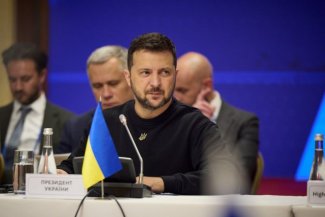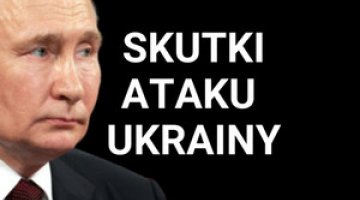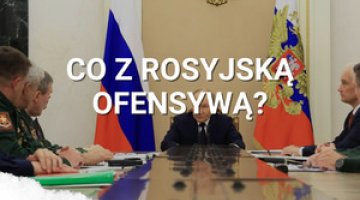The International Defence Industries Forum in Kyiv. Day 586 of the war

The Russians have been continuing their attacks on Ukrainian infrastructure at the rear of the frontline. On 30 September, kamikaze drones struck Kalinivka in Vinnytsia oblast (where an ammunition depot was probably destroyed) and the port of Yuzhne in Odesa oblast, while rockets struck Kramatorsk and Zaporizhzhia (where a critical infrastructure facility was hit) as well as Matviyivka in Zaporizhzhia oblast. According to Ukrainian reports, the invaders fired a total of eight missiles and 40 Shahed-136/131 drones, 30 of which were destroyed. On 1 October, Russian missiles hit Kharkiv (once again the target was the Kharkovskyy Bronetankovy Zavod, which repairs heavy armaments and military equipment) and the town of Druzhkivka in Donetsk oblast (a critical infrastructure facility was hit), while drones hit Uman in Cherkasy oblast (where warehouses at an industrial facility were destroyed), Kryvyi Rih and Snihurivka in Mykolaiv oblast. The Russians used 10 rockets and 30 drones in this attack, 16 of which were shot down. On 2 October, the invaders’ rockets (eight in total) hit the area around Kharkiv and the village of Oleksandro-Kalynove in Donetsk oblast, and more drones (seven in total, of which the defenders shot down four) hit Kryvyi Rih. The same day also saw further intense shelling of Kherson city, in which one civilian was killed and several wounded. In the attacks of3 October, industrial facilities in Dnipro and Pavlohrad in Dnipropetrovsk oblast were targeted. The Ukrainian Air Force Command declared that it had shot down 29 of the 31 drones and one Iskander-K cruise missile used by the Russians.
On 1 October, Ukrainian kamikaze drones attacked the Sochi airport in Krasnodar krai as well as the Smolensk aviation plant. According to the Russian side, all the drones (four in total) were shot down, although shrapnel from one of them fell near the airport. On 2 October, Ukrainian military intelligence (HUR) reported that “significant damage” had been sustained at the Smolensk plant, which manufactures the Kh-59 missiles which have been used in the attacks on Ukraine. On 1 October, the Ukrainians also attacked Dzhankoy in Crimea, resulting in damage to a warehouse; according to the Russians, two Grom-2 ballistic missiles were shot down, and damage was caused by the falling debris. On 30 September, a Ukrainian drone attack resulted in a fire at a power substation in Pogar in Russia’s Bryansk oblast.
There has been no significant change in the situation in the combat zones. The offensive actions taken by both sides are limited in nature (attacks are being carried out in small groups numbering no more than a dozen people), and have not led to any breakthroughs of the enemy’s defences. In its communiqués, the Ukrainian General Staff emphasises that the Russian counter-attacks in those areas where the Ukrainian army made advances during the summer (namely south-east of Bakhmut and south of Orikhiv and Velyka Novosilka) have been ineffective, as have their successive assaults at Marinka and on the flanks of Avdiivka. On 1 October, the spokesman for the Eastern Group of Forces of the Armed Forces of Ukraine, Illia Yevlash, reported that the Russians had finished assembling a group of the new 25th Combined Arms Army (CAA) in the Kreminna area of Luhansk oblast. It is expected to number more than 17,000 troops when completed. According to Yevlash, the 25th CAA has relieved a group of the 41st CAA and the 76th Airborne Division, which had suffered “significant losses”.
On 2 October, Germany announced the transfer of a new support package to the Ukrainian army, which includes 14 BV206 articulated tracked carriers, two Wisent 1MC armoured recovery vehicles, one Biber tank bridge, seven HX81 trucks and nearly 33,000 rounds for 40-mm grenade launchers. According to the German economy ministry, in the first three quarters of this year the government has approved the export of arms and military equipment worth €3.3 billion to Ukraine. Kyiv has thus became the German arms industry’s largest customer (in the period under review, the total value of exports approved by Berlin reached €8.76 billion, after taking sales to other countries into account).
On the same day, the Polish Armaments Group (PGZ) announced the handover to Ukraine of the first Leopard 2 tanks overhauled in Gliwice, as well as the overhaul of further units, the number of which was not disclosed. A comprehensive service centre for tanks based on Soviet designs will also be established in Poland (the PGZ has already started overhauling Ukrainian T-64s). Meanwhile the Danish defence ministry has announced that Copenhagen has donated 100 million kroner ($14 million) for the European Defence Agency’s joint purchase of artillery ammunition for Ukraine, which is expected to reach the recipients in 2024. As reported by the Middle East Eye news agency, the Turkish company Canik has supplied Ukraine with 600 M2 large-calibre machine guns to combat drones. On 2 October, the French announced the handover of a further six 155-mm CAESAR howitzers.
On 29 September, the First International Defence Industries Forum (DFNC1) was held in Kyiv. According to a communiqué issued by the Ukrainian side the following day, President Volodymyr Zelensky announced the creation of the Alliance of Defence Industries, to which he invited companies from Ukraine and around the world. According to the Ukrainian foreign ministry, 38 companies from 19 countries had signed up by the time the Forum closed. Zelensky also announced plans to set up a special defence fund, to be financed by dividends from state defence assets and profits from the sale of confiscated Russian property. The funds accumulated are to be used to provide additional support for the arms industry’s development programmes, other programmes important for defence, and for the care of soldiers. Prime Minister Denys Shmyhal stated that the draft budget for 2024 plans to spend 55.8 billion hryvnias (c. $1.5 bn) on preparations for armaments production, seven times higher than this year’s figure. He also recalled that 37 Ukrainian armaments enterprises have been destroyed as a result of Russian attacks. The Ukrainian foreign ministry stated that the Ukrainian side had signed 20 documents of varying degrees of importance with its foreign partners during the Forum, which was attended by 252 companies from 31 countries.
On 29 September, the French defence ministry presented the results of a visit to Kyiv by a delegation led by the minister Sébastien Lecornu and attended by some 20 representatives of the French arms industry. During DFNC1, French entrepreneurs signed nearly 20 contracts, letters of intent and memoranda of cooperation with Ukrainian users and potential service providers of French-supplied armoured vehicles, artillery and drones, as well as cyber security and demining facilities.
On 30 September, the management of the Turkish company Baykar reported their participation in the Forum. The company is to build a Turkish-licensed drone plant in Ukraine by the end of next year, which should employ a minimum of 300 workers. The company wants to invest $100 million in this project, as well as in the company’s service centre and an office in Kyiv. Meanwhile the Czech defence ministry announced that it had reached an memorandum during DFNC1 to transfer a licence to the Ukrainian side for the production of CZ BREN 2 carbines. The Czech company Sellier & Bellot will also help the Ukrainians organise the production of small-arms ammunition.
On 30 September, the Romanian defence ministry reported that an air alert had been issued to residents of villages near the Romanian town of Galaţa late in the evening of the day before, during another Russian attack on Ukrainian ports along the Danube. Radar systems had detected the unauthorised entry of an unidentified object into the country’s airspace. Earlier, a defence ministry spokesman said there was no indication that Russia was targeting Romania, but the nature of the attacks on nearby Ukrainian territory made it impossible to prevent all airspace violations. Romania imposed a ban on flights near its border with Ukraine on 14 September.
On 30 September, referring to the practice of forced passportisation of residents of the occupied territories (obtaining a Russian passport is a condition for receiving financial handouts, among other things), Ukrainian human rights ombudsman Dmytro Lubinets stated that once these territories have been liberated, people holding Russian documents will not be penalised for accepting them.
According to an order from the Ukrainian defence ministry, as of 1 October women aged between 18 and 60 with medical and pharmaceutical training will be required to register with military commissions. However, as explained, this will not entail mobilisation into the army, and taking up service will remain voluntary. The registration process will last until 2026, after which women with the relevant education but who have not regularised their military service status will not be permitted to take up a job in line with their professional qualifications. Evasion of military registration is punishable by a fine of up to 1700 hryvnias (c. $50).
On 29 September, President Vladimir Putin signed a decree on the start of autumn conscription in the Russian army, which will run from 1 October to the end of December. The plan is to draft 130,000 men aged between 18 and 27 who have not previously performed military service. From next year, legislation raising the upper age limit for conscripts to 30 will come into effect.
Commentary
- Contrary to what had been reported since August, the International Defence Industry Forum held in Kyiv was not a business event. It was initially reported that the Ukrainians would try to reactivate the Arms and Security arms fair which had been held regularly before the full-scale invasion by Russia, but in the end the event was reduced to a one-day conference which was political in nature. Its overriding aim was to interest potential Western investors in rebuilding Ukraine’s arms industry, but – contrary to declarations that 252 companies from 31 countries would participate – the Forum was mainly attended by representatives of the governments of countries which are militarily supporting Ukraine. Unlike the arms fair, no list of the participants at the DFNC1 was published, and only a few delegations and (officially) only one company (Turkey’s Baykar) decided to announce their presence publicly.
- Kyiv’s efforts to interest Western partners in investing in Ukraine’s arms industry have so far failed to yield significant results. It is reasonable to assume that this situation will not change much as long as hostilities continue on Ukrainian territory. Only one agreement – the one reached with the Turkish drone manufacturer Baykar, and that even before the full-scale Russian invasion began – provides for the construction of a new production facility in Ukraine. The UK’s BAE Systems and Germany’s Rheinmetall have pledged to set up service centres in the country and (in the case of BAE) to locate the production of components for the old 105-mm howitzer type in Ukraine. By doing so, they have made a tentative promise to increase the scope of this cooperation in the future. However, neither service centre will be launched before 2024 at the earliest (the British and Germans have not yet even opened the offices in Kyiv which they had announced). Meanwhile France, which is responsible for most of the documents signed during the DFNC1, has made no secret of the fact that their cooperation is primarily aimed at selling the products of the French arms industry on the Ukrainian market. Cooperation with Ukrainians on their territory remains the domain of Polish companies: WB Ukraine has been operating there since 2020, and PGZ Serwis Orel since May this year.





